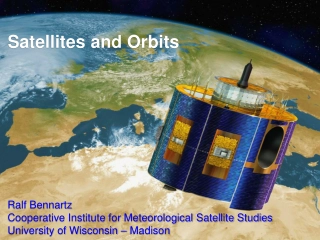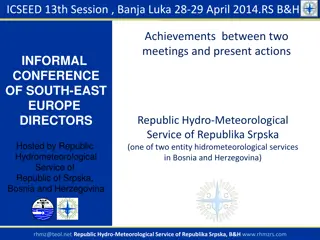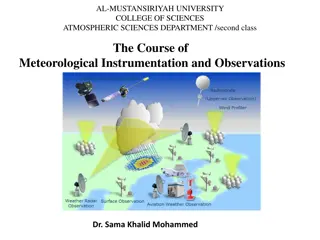Satellites and Orbits
The realm of satellites and orbits, covering topics such as Kepler's Laws, meteorological satellite orbits, the history of satellite remote sensing, and different types of orbits including geostationary and sun-synchronous orbits. Explore the significance of inclination angles, orbital speeds, and d
3 views • 22 slides
Advancements in Solar-Terrestrial Research and Meteorology
The Solar-Terrestrial Centre of Excellence (STCE) focuses on ongoing activities and opportunities in the field of meteorology, with a special emphasis on Antarctica. Their annual meetings cover topics like water vapor feedback mechanisms, extreme weather events forecasting, cloud and precipitation s
0 views • 14 slides
Environmental Workshop Overview: Ministry of Environment in the Solomon Islands
The Environment and Conservation Division (ECD) of the Ministry of Environment, Climate Change, Disaster Management, and Meteorology in the Solomon Islands focuses on sustainable environmental management, conservation, and protection of natural resources. The ECD's vision is to safeguard the environ
1 views • 15 slides
Precipitation in Meteorology
Precipitation in meteorology is the result of atmospheric water vapor condensing and falling to Earth, a vital element of hydrology. It can occur in liquid or solid forms through processes like evaporation, cooling, condensation, and droplet growth. Different geographic and climate conditions impact
0 views • 17 slides
Restructuring of USACE HEC-HMS Meteorologic Model
Significant modifications have been made to the HEC-HMS meteorologic model to enhance modeling tasks' ease and intuitiveness. The Met Model Restructure updates in versions 4.9 to 4.11 streamline meteorologic processes, introduce new features like automatic linkages and zonal editors for snowmelt, an
0 views • 19 slides
Insights into Agrometeorology: Importance, Applications, and Impact
Agrometeorology serves agriculture by aiding in land use, food production, and resource management. It plays a crucial role in strategic agricultural decisions, such as irrigation schemes, crop selection, and machinery use. Weather forecasts and climate patterns are key for effective planning, espec
0 views • 8 slides
Forces Affecting Air Movement: Pressure Gradient Force and Coriolis Force
The pressure gradient force (PGF) causes air to move from high pressure to low pressure, with characteristics including direction from high to low, perpendicular to isobars, and strength proportional to isobar spacing. The Coriolis force influences wind direction due to the Earth's rotation, making
1 views • 20 slides
Experimental Lightning Flash Prediction Based on Real-Time Forecast
This PowerPoint presentation provides real-time experimental lightning flash prediction based on initial conditions data from GFS and WRF models. The forecast covers Day 1 and Day 2 with detailed insights on 24-hour accumulated total lightning flash counts and 3-hourly accumulated total lightning fl
0 views • 8 slides
Real-Time Experimental Lightning Flash Prediction and Analysis
Cutting-edge real-time lightning flash prediction model output for Day1 with 24-hour accumulated total lightning flash counts and 3-hourly accumulated total lightning flash counts overlaid with max reflectivity data. Stay tuned for Day2 forecast updates. Prepared by experts at the Indian Institute o
0 views • 8 slides
Synoptic Meteorology: A Comprehensive Overview
Synoptic meteorology delves into various aspects of atmospheric sciences, encompassing scales of atmospheric motion, weather maps, air masses, fronts, jet streams, and more. Through the study of synoptic meteorology, meteorologists gain insights into interpreting the state of the troposphere and for
1 views • 17 slides
Real-time Experimental Lightning Flash Prediction Report
This Real-time Experimental Lightning Flash Prediction Report presents a detailed analysis of lightning flash forecasts based on initial conditions. Prepared by a team at the Indian Institute of Tropical Meteorology, Ministry of Earth Sciences, India, the report includes data on accumulated total li
0 views • 6 slides
Real-time Lightning Flash Prediction Research Update
Experimental lightning flash prediction based on initial conditions for Day 1, including total lightning flash counts and hourly accumulated data with maximum reflectivity overlays. Day 2 forecast updates coming soon. Prepared by the Indian Institute of Tropical Meteorology.
0 views • 8 slides
Experimental Lightning Flash Prediction Report
Real-time lightning flash prediction report based on initial conditions. Prepared by a team at the Indian Institute of Tropical Meteorology, Ministry of Earth Sciences, India. Includes 24-hour accumulated total lightning flash counts data for Day1, along with 3-hourly accumulated total lightning fla
0 views • 6 slides
SERCOM-3 Gender Action Plan History and Evolution
The Gender Action Plan within the World Meteorological Organization (WMO) has evolved over the years to promote gender equality in meteorology, hydrology, and related sciences. Initially formulated in 2007, it was revised in 2015 and updated in subsequent years to include activities such as promotin
0 views • 6 slides
Alumni of the Month Ryan Lueck - Graduate Student Spotlight
Ryan Lueck, Alumni of the Month, shares his journey from undergraduate studies in meteorology to graduate school focusing on upward lightning phenomena. He provides insights into his experience in graduate school, his research on lightning, and offers valuable advice for those interested in pursuing
1 views • 5 slides
Meteorological Data Analysis and Visualization Tools for Regional Weather Services
Explore advanced tools and technologies for analyzing and visualizing meteorological data in regional weather services. From observational variables to forecast and ensemble models, learn about different plotting methods, interactive features, and map layers used in the field of meteorology. Enhance
0 views • 6 slides
The Fundamentals of Synoptic Meteorology at Mustansiriya University
Dive into the course of Synoptic Meteorology offered at Mustansiriya University with topics covering atmospheric motion scales, weather maps, air masses, fronts, and jet streams. Learn how to analyze and interpret weather data through the study of high and low-pressure systems, jet streams, and more
0 views • 17 slides
Evaluation and Improvement of Cloud and Precipitation Physics in Hurricane Weather Forecasting
Yuqing Wang from the Department of Meteorology at the University of Hawaii worked on evaluating and enhancing cloud and precipitation physics in the operational Hurricane Weather Research and Forecast (HWRF) model. The project aimed to improve hurricane intensity and structure predictions, focusing
0 views • 18 slides
Model Evaluation in Meteorology
Model evaluation in meteorology involves verifying, hypothesizing, proving, and improving models through a systematic process. Factors such as error analysis, grid spacing, model resolution, domain size, computational errors, chaotic equations, and initial condition errors play critical roles in ass
0 views • 17 slides
Air Masses in Meteorology
Air masses play a significant role in meteorology, covering vast areas with uniform physical properties. They are classified based on temperature, moisture content, and source regions, which can be continental or maritime. Air masses form in regions with little wind and can sit over an area for an e
0 views • 27 slides
Innovations in Hydro-Meteorological Observatories for Sustainable Environmental Monitoring
This document showcases various design principles and technologies used in the Trans-African Hydro-Meteorological Observatory project, aiming to enhance data collection in meteorology and hydrology for sustainable land monitoring. Key features include robust, low-cost, and self-calibrating systems t
0 views • 33 slides
Insights on Fire and Soil Moisture Relationships from Max-Planck-Institute Research
Explore the fascinating research findings on the interaction between fire dynamics and soil moisture content, as studied by scientists from the Max-Planck-Institute for Meteorology in Hamburg. Discover details on burned areas, carbon emissions, biomass consumption, fire impacts on vegetation, and mo
0 views • 18 slides
Insights into Meteorology and Warning Systems at Iowa State University
Discover the journey of Daryl Herzmann, a meteorology expert from Iowa State University, as he shares his experiences working with NWS and creating tools like NWSChat. Explore the concept of "Dog and Pony Show," his achievements, and the purpose of his maps in understanding weather gradients.
0 views • 66 slides
Wind Measurement and Observation Techniques
Wind speed and direction are crucial parameters in meteorology. This article explores the measurement of wind speed using a Cup Counter Anemometer and the procedures for recording wind observations. It also delves into the methods for measuring wind direction. Understanding these techniques is essen
0 views • 16 slides
Ministry of Meteorology, Energy, Information, Disaster Management, Environment, Climate Change & Communications (MEIDECC) Tonga Energy Roadmap (TERM) 10-Year Plan (2010-2020)
The MEIDECC in Tonga developed a comprehensive 10-year energy roadmap, outlining phases, funded activities, and lessons learned. The plan addresses socio-economic and environmental characteristics, emphasizing the impacts of urbanization and migration on energy consumption and investment. Noteworthy
0 views • 26 slides
Exploring Weather - Investigation 1: The Air Around Us
Dive into the fascinating world of weather with Investigation 1, which focuses on understanding the air around us. Through various activities and discussions, students explore the concepts of climate, weather, and the role of air in shaping our daily environment. This investigation sets the stage fo
0 views • 29 slides
Weekly Educational Overview - Feb 1-5, 2021
Explore climate, weather, equations, and inequalities in this week's educational agenda. Topics include the sun's impact, wind movement, multiplication, division equations, radiation, meteorology, and more.
0 views • 10 slides
Real-time Experimental Lightning Flash Prediction for Lightning/TS Forecast
Real-time experimental lightning flash prediction based on initial conditions, including 24-hour accumulated total lightning flash counts and 3-hourly accumulated total lightning flash counts with max reflectivity overlaid. Presentation prepared by the Indian Institute of Tropical Meteorology for sc
0 views • 8 slides
Informal Conference of South-East Europe Directors on Hydro-Meteorological Services
ICSEED 13th Session in Banja Luka focused on achievements and actions between meetings of Hydro-Meteorological Services in Bosnia and Herzegovina. The conference highlighted the Memorandum of Understanding between different institutions for cooperation in meteorology and hydrology. Through cross-bor
0 views • 23 slides
Satellite Technology in Meteorological Forecasting
Egbert Quatre, a Forecasting Officer, utilizes satellite technology for weather forecasting. He uses EUMETSAT and Fengyun satellites to analyze cloud features, weather patterns, and extreme events. Challenges include the lack of now-casting tools and the need for more trained forecasters in Satellit
0 views • 8 slides
Collaboration Opportunities in Meteorology for Islamic Countries
The Ministry of Forestry and Water Affairs in Turkey, along with the Turkish State Meteorological Service, organized a meeting for General Directors of Meteorological Agencies from Islamic countries in May 2017 in Istanbul. The areas of possible cooperation included observations and observing system
0 views • 9 slides
Frontogenesis and Frontolysis in Meteorology
Meteorology enthusiasts can explore the concepts of frontogenesis and frontolysis, the evolution of cyclones, and the role of the Norwegian School Meteorologists in describing fronts. Dive into the mechanisms behind the formation and weakening of horizontal temperature gradients, the interaction bet
0 views • 60 slides
Portraits and Landscapes: A Diverse Collection from Brauer Museum
Explore a captivating collection featuring portraits by renowned artists and landscapes that depict diverse styles and themes. Delve into the world of American literature, art history, biology, meteorology, economics, and more through the lens of talented individuals showcased at Brauer Museum.
0 views • 4 slides
Atmospheric Stability and Lapse Rates in Meteorology
Explore the concepts of lapse rates, stability determination, adiabatic processes, and cloud formation in meteorology. Learn how to calculate lapse rates, assess atmospheric stability, and predict cloud formation conditions based on temperature changes with altitude. Dive into real-world examples an
0 views • 13 slides
Pressure Surfaces and Environmental Lapse Rates in Meteorology
This content discusses how pressure surfaces slope from low to high latitudes due to temperature changes, calculating the slope of pressure surfaces at different latitudes, determining wind speed based on slope, computing environmental lapse rates, and analyzing stability using dry and moist adiabat
0 views • 12 slides
Radiosonde Technology and Upper Atmosphere Measurements in Meteorology
Upper atmosphere measurements above the surface are crucial for forecasting and research in meteorology. Radiosondes, carried by balloons, provide data on pressure, temperature, humidity, wind speed, and direction. These measurements are vital for analyses and research, especially in emergency situa
0 views • 19 slides
Virtual Temperature in Meteorology
Virtual temperature (TV) is a crucial concept in meteorology, representing the temperature a dry air parcel would have under specific conditions. It allows for adjustments in convective potential energy assessments and is essential for interpreting Skew-T log-P diagrams. When calculated accurately,
0 views • 4 slides
Atmospheric Sciences 370
Dive into the world of atmospheric sciences with a focus on synoptic meteorology. Explore the structure and evolution of weather systems, ranging from fronts and cyclones to jets and vorticity. Gain hands-on experience with observational tools, satellite imagery, and radar interpretation essential f
0 views • 7 slides
Engaging Review Game for Learning Meteorology Concepts
Dive into a stimulating review game focused on meteorology concepts like water vapor, cloud types, heat transfer, air cycles, and seasonal changes. In a competitive Round Robin format, participants answer questions to earn points while staying alert for deductions due to incorrect responses and outs
0 views • 46 slides
Time in Meteorology
Meteorology relies on precise timekeeping for global data exchange. Meteorologists use standardized times like UTC, Z, or GMT based on Greenwich Mean Time. Learn how to convert between Pacific Time and UTC for accurate weather mapping.
0 views • 6 slides







































